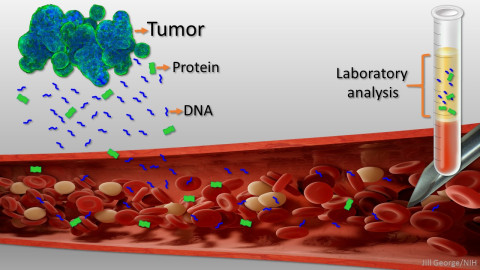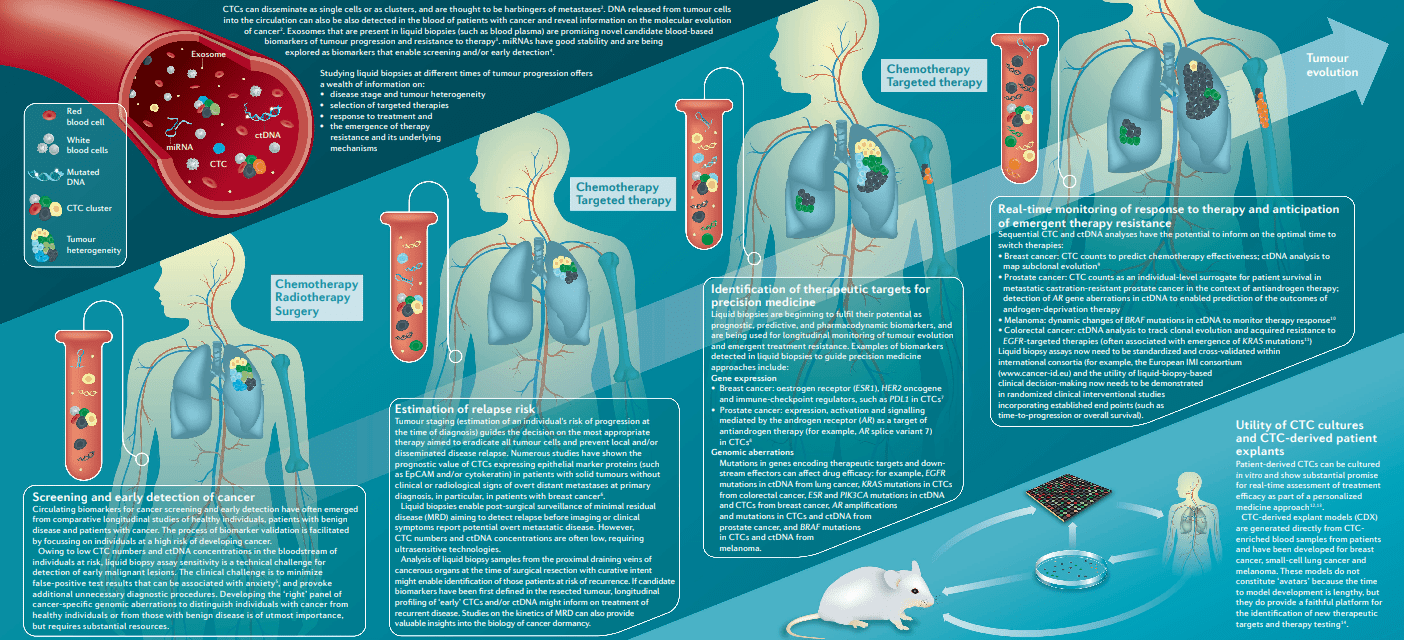Liquid biopsy of cancer
With a blood sample we can fight cancer
We now know that tumors release into the bloodstream a large number of molecules specific to each tumor in most early and advanced stage cancers.
The concept of “liquid biopsy” refers to the detection of molecules that come from tumors, through the analysis of circulating tumor cells (CTC), circulating tumor DNA (ctDNA), microRNAs (miRNAs) and exosomes.
CTCs can be disseminated as individual cells or as clusters, and are thought to be precursors of metastasis. DNA released from tumor cells in the circulation can also be detected in the blood of cancer patients and reveal information on the molecular evolution of cancer. The exosomes that are present in liquid biopsies (such as blood plasma) are promising and novel Biomarkers present in the blood with which we can know the tumor progression and resistance to therapy.
The liquid biopsies allow post-surgical surveillance of minimal residual disease (RRM) in order to detect relapse before the image or the manifestation of clinical symptoms that indicate a potential metastatic disease.
- Early detection
- Estimation of the risk of relapse.
- Stage of the disease and tumor heterogeneity
- Selection of targeted therapies.
- Response to treatment and resistance to treatments
- Real-time monitoring of the response to therapy and anticipation of resistance to emergent therapy.

Early detection of cancer
Circulating biomarkers for the early detection of cancer have emerged from longitudinal studies, comparing healthy patients with patients with benign disease and patients with cancer. With these studies, the validation process of biomarkers has been facilitated. focusing on individuals with a high risk of developing cancer. Due to the low numbers of CTC and the concentrations of ctDNA in the bloodstream of individuals at risk, the sensitivity of the liquid biopsy assay is a technical challenge for the detection of early malignant lesions. The clinical challenge is to minimize false-positive test results that can be associated with anxiety, and cause additional unnecessary diagnostic procedures. Developing the “correct” panel of cancer-specific genomic aberrations to distinguish individuals with cancer from healthy individuals or those with benign disease is of paramount importance, but requires substantial resources.
Estimation of the risk of relapse.
Tumor staging (estimation of the risk of progression of an individual at the time of diagnosis) orients the decision on the most appropriate. The therapy aims to eradicate all tumor cells and prevent local and / or relapse of disseminated disease. Numerous studies have shown the prognostic value of CTCs expressing epithelial marker proteins (such as EpCAM and / or cytokeratin) in patients with solid tumors without clinical or radiological signs of distant metastases in the primary. This diagnostic tool has been useful in particular in patients with breast cancer.
The liquid biopsies allow post-surgical surveillance of minimal residual disease (RRM) in order to detect relapse before the image or the manifestation of clinical symptoms that indicate a potential metastatic disease.
However, CTC numbers and ctDNA concentrations are often low, which requires ultrasensitive technologies. Analysis of liquid biopsy samples from the proximal extraction veins of cancerous organs at the time of surgical re-section with curative intent. could allow the identification of those patients with risk of recurrence. If a patient’s biomarkers are identified from the primary tumor, performing “early” CTC profiles and / or ctDNA could inform about the treatment of recurrent disease. Studies on EMR kinetics can also provide valuable information on the biology of cancer latency.
Identification of therapeutic targets for precision medicine
Liquid biopsies are beginning to fulfill their potential as prognostic, predictive and pharmacodynamic biomarkers, and are being used for longitudinal monitoring of tumor evolution and resistance to emerging treatment. Examples of biomarkers detected in liquid biopsies to guide precision medicine approaches include:
Gene expression
- Breast cancer: estrogen receptor (ESR1), HER2 oncogene and immune checkpoint regulators, such as PDL1 in CTCs7
- Prostate cancer: expression, activation and signaling mediated by the androgen receptor (AR) as the target of antiandrogen therapy (for example, splice variant AR 7) in CTCs8
Genomic aberrations:
Mutations in genes encoding therapeutic targets and subsequent effectors may affect the efficacy of the drug: for example, EGFR mutations in lung cancer ctDNA KRAS mutations in CTC of colorectal cancer, ESR and PIK3CA mutations in ctDNA and cancer CTC of breast, AR amplifications and mutations in CTC and ctDNA of prostate cancer, and BRAF mutations in CTC and melanoma ctDNA.
